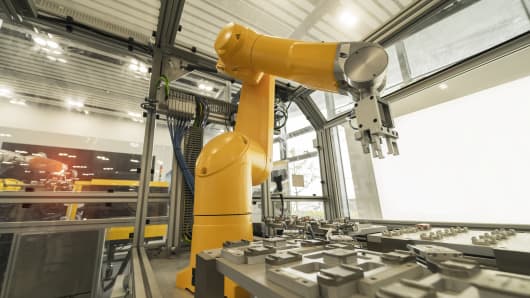AI and robotics will create almost 60 million more jobs than they destroy

Developments in automation technologies and artificial intelligence could see 75 million jobs displaced, according to the WEF report "The Future of Jobs 2018." However, another 133 million new roles may emerge as companies shake up their division of labor between humans and machines, translating to 58 million net new jobs being created by 2022, it said. At the same time, there would be "significant shifts" in the quality, location and format of new roles, according to the WEF report, which suggested that full-time, permanent employment may potentially fall. Some companies could choose to use temporary workers, freelancers and specialist contractors, while others may automate many of the tasks. New skill sets for employees will be needed as labor between machines and humans continue to evolve, the report pointed out. Machines are expected to perform about 42 percent of all current tasks in the workplace by 2022, compared to only 29 percent now, according to firms surveyed by WEF. Humans are expected to work an average of 58 percent of task hours by 2022, up from the current task hours of 71 percent.
The Digital Boardroom: Industrial Boards Are Looking for More Tech-Savvy Directors

It is not enough to be fluent in Industry 4.0; directors have to be able to connect technology to the business in meaningful and tangible ways that will boost shareholder performance. If they are to be seen as respected contributors to the board, directors need to help educate other directors on the implications of technology and bring the leadership skills and business knowledge to advance the broader board’s understanding of the issues at play for the business. Without this broader business perspective, they may lack the influence with other directors and limit their effectiveness in board-level debates about strategy and capital spending. In addition, having a quantifiable way to measure digital transformation and its connection to financial outcomes will be key to their success. Ideas that were too futuristic ten years ago are now a reality, thanks to digital transformation. For example, who knew cars could drive themselves or drones could deliver packages.
All your Windows 10 devices, managed by Microsoft
The complexity of managing previous versions of Windows has meant that handing over PC management to managed service providers and outsourced IT was rarely economic. Microsoft is betting that its new versions of Windows and Office — as well as its cloud analysis and management tools — make it cost effective to take over desktops at scale, whether that management is done by Microsoft; OEMs such as Dell and HP, which already offer on-demand device replacement; or partners such as Avanade/Accenture and Computacenter. Microsoft has “tens of customers” for MMD in the UK and US, including large, regulated organizations like Lloyds Banking Group as well as SMBs like Seattle Reign. Karagounis says the MMD baseline caters for large regulated companies but “we give the smaller organizations a choice with things they don’t want to light up because they’re too heavy-duty.” The program will expand to Canada, Australia and New Zealand in early 2019 and other geographies later in the year.
This Windows file may be secretly hoarding your passwords and emails

Since the Windows Search Indexer service powers the system-wide Windows Search functionality, this means data from all text-based files found on a computer, such as emails or Office documents, is gathered inside the WaitList.dat file. This doesn't include only metadata, but the actual document's text. "The user doesn't even have to open the file/email, so long as there is a copy of the file on disk, and the file's format is supported by the Microsoft Search Indexer service," Skeggs told ZDNet. "On my PC, and in my many test cases, WaitList.dat contained a text extract of every document or email file on the system, even if the source file had since been deleted," the researcher added. Furthermore, Skeggs says WaitList.dat can be used to recover text from deleted documents. "If the source file is deleted, the index remains in WaitList.dat, preserving a text index of the file," he says. This provides crucial forensic evidence for analysts like Skeggs that a file and its content had once existed on a PC.
3 first steps to explore blockchain in the enterprise
Blockchain and digital assets can take a while to fully understand and you really need to be willing to read, listen and experiment. When tackling any complex topic, I begin with reviewing and discussing the topic with credible sources I really trust. We expanded several of our existing collaboration relationships with forward-thinkers, such as the Ideo CoLab and the Institute for the Future, and we joined working groups across industry and academia, with organisations including Harvard University, University College London, the MIT Media Lab and IC3. We paired this outside knowledge with our own analysis. We also conduct user research with Fidelity clients and customers to gain an understanding of their interest and activity in this area, which has helped inform our pilots. ... When we started to explore the possibilities for capital markets, we started with the obvious pain points – specifically, money movement, transactions and payments. This really caught my interest as there was a lot of speculation about the day-to-day usefulness of digital assets.
AI for Crime Prevention and Detection – Current Applications

Companies and cities all over world are experimenting with using artificial intelligence to reduce and prevent crime, and to more quickly respond to crimes in progress. The ideas behind many of these projects is that crimes are relatively predictable; it just requires being able to sort through a massive volume of data to find patterns that are useful to law enforcement. This kind of data analysis was technologically impossible a few decades ago, but the hope is that recent developments in machine learning are up to the task. There is good reason why companies and government are both interested in trying to use AI in this manner. As of 2010, the United States spent over $80 billion a year on incarations at the state, local, and federal levels. Estimates put the United States’ total spending on law enforcement at over $100 billion a year. Law enforcement and prisons make up a substantial percentage of local government budgets. Direct government spending is only a small fraction of how crime economically impacts cities and individuals.
Blockchain And Token Asset “Phenomena” Still Raging
Citing a report from PWC, as relayed by a recent Bloomberg article, the host went on to note that although 86% of the respondents in a 600-firm survey have begun tinkering with blockchain, that 54% of the aforementioned figure claimed that deploying systems based on this nascent technology “wasn’t justified.” Explaining why this is the case, Mcnamara noted that while blockchain is evidently a viable technology, firms are finding it difficult to deploy blockchain-based commercial solutions in a manner that will become profitable over time. The PWC executive then drew attention to the fact that there are still trust issues between firms and decentralized technologies, which ironically enough are arguably the most secure systems out there, so what’s not to trust? Lastly, Mcnamara brought up the perpetually controversial topic of regulation, adding that firms are wary that governments, specifically US’ regulatory bodies, will eventually lash out at this budding industry. ...”
DevOps security takes on the dark side of digital transformation

DevOps security is the only viable approach as digital assets become crucial to the enterprise bottom line, Pullen said. Ideally, IT employees should access enterprise production environments only with developers' version-controlled code, checked in to an automated delivery system -- a setup that limits internal security threats, he said. The DevOps practice of small, iterative changes to modular infrastructure also reduces the attack surface of IT systems for outside threats. However, DevOps proponents are mistaken to emphasize the gatekeeper mentality that relies on human approvals or manual work to deploy production application changes, Pullen said. "Automated changes to production scares IT folks, but version control should be the gatekeeper," he said. "Version-control systems are fully auditable, reproducible and traceable."
Ajey Gore on Small Teams Making a Big Difference and Effective Outsourcing

There is a fundamental difference in how you look at “outsourcing”. The old school way of looking at this was to outsource for a pure labor arbitrage reason. It was implied cheaper to get work done in India. For us, it’s exactly the opposite. It’s significantly more expensive to set shop in India, but we’re in it for the talent. There is also the added benefit of India being in the top 5 countries with the largest English speaking population. Quality of talent has always been the main focus for us and there is no dearth of the type of talent we’re looking for in India. The quality of talent outweighs the higher price point because we believe in the long run the talent will prove to be more valuable than the savings. In Indonesia, especially with tech-focused companies, I feel the trend of ‘outsourcing to India’ will start to grow slowly as more companies will start to understand the value of experienced and talented developers and their contribution to the long-term goals of a company.
IBM launches tools to detect AI fairness, bias and open sources some code
Strategically, IBM's move makes sense. IBM is hoping to provide Watson AI, but also manage AI and machine learning deployments overall. It's just a matter of time before AI Management becomes an acronym among technology vendors. IBM said it is planning to provide explanations that show how factors were weighted, confidence in recommendations, accuracy, performance, fairness and lineage of AI systems. There is little transparency in the models being sold, inherent bias, or fine print. IBM Research recently proposed an effort to add the equivalent of a UL rating to AI services. IBM said it will also offer services for enterprises looking to better manage AI and avoid black box thinking. Big Blue's research unit recently penned a white paper outlining its take on AI bias and how to prevent it. IBM's Institute for Business Value found that 82 percent of enterprises are considering AI deployments, but 60 percent fear liability issues.
Quote for the day:
"Never stir up litigation. A worse man can scarcely be found than one who does this." -- Abraham Lincoln
No comments:
Post a Comment